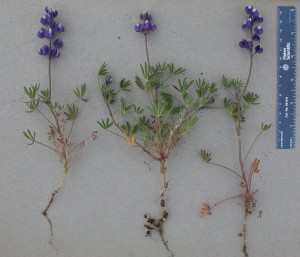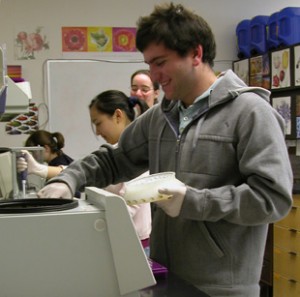“Natural selection cannot possibly produce any modification in any one species exclusively for the good of another species”
Charles Darwin (1859), On the Origin of Species, Chapter Six.
In a mutualism, individuals of one species benefit those of another species and the improved fitness of the recipient feeds back to the donor. These interactions are fascinating because they seem evolutionarily unstable: in the absence of counterselection, natural selection will favor any individual with a mutation that increases fitness benefits received from partners and/or reduces the fitness cost of benefiting partners; the spread of such mutants could break down the mutualism.
Remarkably, many species participate in mutualistic interactions with multiple partners that they acquire from the environment. Selection might maintain cooperation in such mutualisms if controlling individuals choose beneficial “trading partners” from a market of potential “traders” (Noë and Hammerstein 1994). To maintain cooperation and hence mutualism, controlling individuals must accurately target fitness benefits to high-quality partners, quantified as the fitness benefits they provide minus the costs they impose (Bshary and Grutter 2002; Foster and Kokko 2006; Simms and Taylor 2002).
Legumes and rhizobia
 We study the mutualistic interaction between legumes and rhizobia. These soil-dwelling bacteria infect legume roots, enter plant cells, and therein fix atmospheric dinitrogen into plant-available ammonium in exchange for carbohydrates that plants create from atmospheric carbon fixed during photosynthesis. Several features of this mutualism might promote rhizobial exploitation of leguminous hosts, including multiple infections of individual host plants by genetically diverse bacterial genotypes.
We study the mutualistic interaction between legumes and rhizobia. These soil-dwelling bacteria infect legume roots, enter plant cells, and therein fix atmospheric dinitrogen into plant-available ammonium in exchange for carbohydrates that plants create from atmospheric carbon fixed during photosynthesis. Several features of this mutualism might promote rhizobial exploitation of leguminous hosts, including multiple infections of individual host plants by genetically diverse bacterial genotypes.
Legume-rhizobium interactions are easy to study because each partner can be propagated independently and fitnesses of both plant and bacteria can be directly estimated. Thus, assumptions and predictions from theory can be tested with manipulative experiments. For example, in a greenhouse experiment with a wild California legume, Lupinus arboreus, we inoculated individual plants with two Bradyrhizobium isolates that differed in the benefit they provided to hosts (Simms et al. 2006). We found that, although plants frequently hosted less cooperative strains, the nodules occupied by these strains were smaller. We also found that larger nodules house more Bradyrhizobium cells, which suggests that plants target fitness benefits to better cooperators.
The need for host traits that can target resources to more-cooperative strains depends on the assumption that cooperation by rhizobia involves fitness costs, yet there has been little empirical evidence to support this assumption. Paradoxically, hosts that counter selection for less rhizobium cooperation by targeting resources to more cooperative strains might eliminate less-ccoperative strains, which would relax selection for the very traits that control the spread of cheating rhizobia. To tackle this issue, postdoctoral researcher Stephanie Porter analyzed data from an experiment in which she individually inoculated 18 families of the legume species Medicago polymorpha with 17 strains of Ensifer medicae (a kind of rhizobium previously named Sinorhizobium) to measure selection on cooperation in the absence of host counter-selection via resource targeting. In Porter_Simms_2014_EcologyLetters she reports that selection consistently favored less-cooperative rhizobia.
However, host targeting of resources to certain nodules can effectively maintain cooperation only if each nodule houses a single rhizobial genotype. Although many studies report nodules that house more than one rhizobial genotype, virtually all of these studies examine plants that were inoculated with high densities of rhizobia. Graduate student Josha Povich and undergraduate researcher Khushboo Goel examined naturally infected lupine nodules to determine the frequency with which nodules house more than one rhizobial genotype. Check here soon for their results.
Questions about control also influence how effectively host targeting of resources can maintain cooperation in the rhizobial population. Most partner-choice models assume that hosts have complete control of resource allocation. Yet, selection would certainly favor any rhizobial mutation that allowed the bacteria to manipulate host allocation of resources. In a recent model (Akçay & Simms 2011), we showed that if both partners have some control over resource allocation, then host targeting of resources will not maintain cooperation in the rhizobial population. Although there is currently no empirical evidence as to whether symbiotic rhizobia have any control over resource allocation, our model indicates that this should be an important focus of future empirical research.
Figs & Fig-wasps
Visiting graduate student K. Charlotte Jandér explored how mutualism is maintained in the interaction between fig trees and fig wasps. Fig trees produce hundreds of tiny flowers inside each fig. The wasps pollinate the flowers but their larvae feed on seeds inside the fig. Although fig trees can abort figs occupied by non-pollinating wasps, some figs house more than one female wasp. If one wasp pollinates, non-pollinating wasps might get a free ride by provisioning their young without expending the energy needed to collect and carry pollen. This led Jandér to hypothesize that host trees target resources to individual fig flowers rather than to the entire fig. In Jandér et al. 2011, she shows that figs are unable to target resources to individual flowers, suggesting that individual wasps might exploit tree resources and the work of other wasps. Charlotte’s work benefited from the help of many undergraduate assistants.

